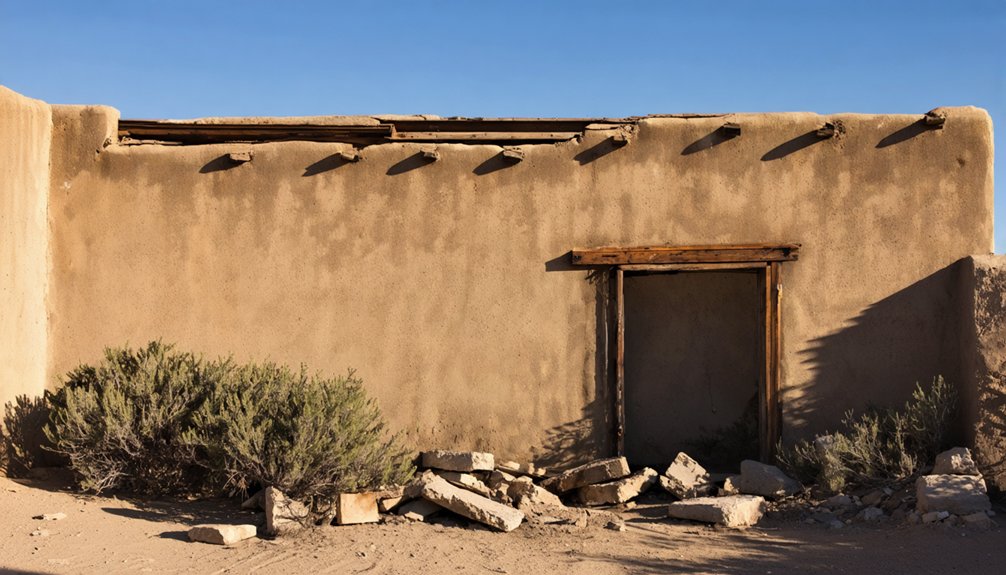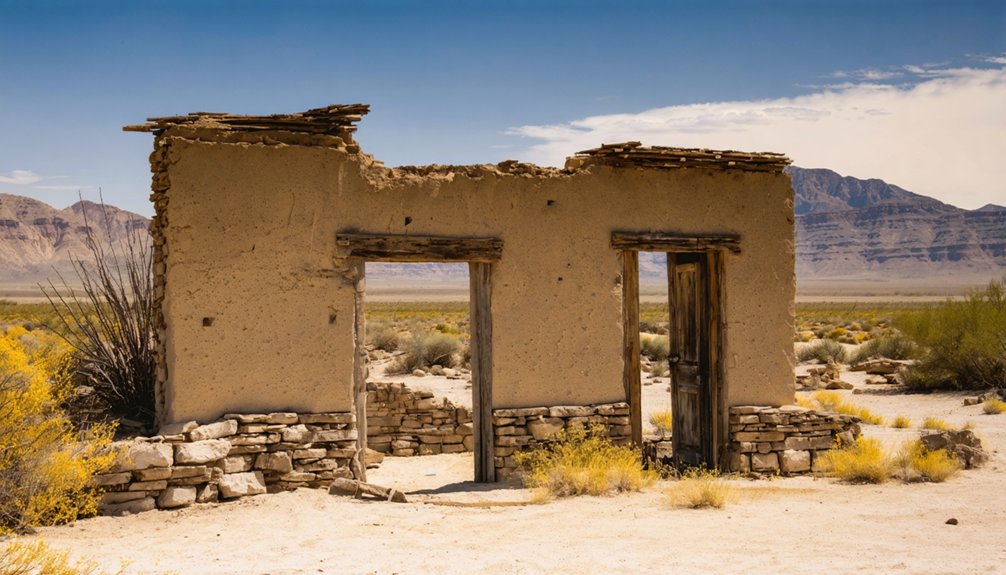You’ll find Fort Quitman’s adobe ruins 80 miles southeast of El Paso, marking a once-vital military outpost established in 1858. The fort protected travelers and mail coaches along the San Antonio-El Paso Road, with Buffalo Soldiers serving there from 1868 to combat Apache raids. After its 1881 abandonment, the settlement declined from 400 residents to fewer than 25 by 1940. Today’s scattered ruins and cemetery tell deeper stories of frontier life and sacrifice.
Key Takeaways
- Fort Quitman transformed from a military outpost to a ghost town after its permanent abandonment in 1881 due to shifting military priorities.
- Located 80 miles from El Paso along the Rio Grande, the site now contains only low adobe mounds marking former military structures.
- Population declined dramatically from 400 residents in the late 1920s to fewer than 25 by 1940.
- Original structures have deteriorated into ruins, with scattered period artifacts and a historic cemetery remaining as evidence of settlement.
- The ghost town’s remains are accessible via Farm Road 192, 16 miles southwest of Sierra Blanca, Texas.
The Birth of a Frontier Military Post
When the U.S. military sought to protect its southwestern frontier in 1858, they established Fort Quitman along a strategic section of the Rio Grande. The fort’s establishment came on September 28, when Capt. Arthur T. Lee led companies C and H of the Eighth Infantry to a barren, sandy plain 80 miles downstream from Fort Bliss.
You’ll find this military strategy was carefully calculated. The fort’s position guarded essential junctions where Indian war trails crossed the San Antonio-El Paso route.
Named after the recently deceased Mexican War General John A. Quitman, the post became part of a larger network of frontier defenses. The initial construction, though rudimentary, included adobe buildings positioned 400 yards from the river, ensuring control of this crucial crossing point. The fort’s soldiers faced harsh living conditions in what would become known as one of the most uncomfortable installations in Texas. After the Civil War ended, the U.S. Army reoccupied Fort Quitman as part of their effort to regain control of the frontier.
Life at the Fort During Early Years
Despite Fort Quitman’s strategic location, daily life proved grueling for its stationed soldiers. You’d find them weathering harsh conditions on a barren, sandy plain, where crumbling adobe buildings offered little comfort from the unforgiving climate.
Similar to Fort Lancaster, isolation posed significant challenges for the troops stationed at Fort Quitman. Soldier camaraderie became essential as troops faced the isolation of being stationed 80 miles from El Paso.
Daily routines centered on protecting mail coaches and travelers along the San Antonio-El Paso route. You’d see companies from the Ninth Cavalry and Twenty-fifth Infantry conducting exhausting patrols, scouting for Mescalero Apache activity across the rugged terrain. The fort’s mission continued until Victorio’s death prompted its permanent closure in 1881.
With limited natural resources, they’d rely heavily on supply lines for basic necessities. A small community emerged around the fort, including a post office run by Veronica Stovall, providing a slim connection to the outside world.
Buffalo Soldiers and Their Legacy
The arrival of Buffalo Soldiers at Fort Quitman in January 1868 marked a pivotal chapter in African-American military history. Under Major Albert Payson Morrow‘s command, the 9th Cavalry Regiment and 42nd Infantry took charge of protecting the essential San Antonio-El Paso Road.
You’ll find that these African American contributions were significant to the region’s development. The Buffalo Soldiers faced intense challenges, from Apache raids to harsh desert conditions, yet maintained unwavering professionalism. Despite living in quarters with collapsing adobe walls, they persevered in their duties. The troops spent much of their time repairing buildings to maintain basic living conditions.
They fought significant battles at Indian Hot Springs and Tinaja de las Palmas, with some making the ultimate sacrifice. Their presence helped secure regional peace by 1885, enabling safer travel and settlement across western Texas.
Native Americans named them “Buffalo Soldiers” out of respect for their fierce fighting spirit, leaving a lasting legacy of courage and resilience.
Strategic Importance Along the Rio Grande
Standing as a sentinel on the Rio Grande, Fort Quitman occupied an essential position approximately 20 miles southeast of present-day McNary and 80 miles downstream from El Paso.
You’ll find this strategic outpost situated 400 yards from the river, perfectly positioned for border management and military logistics along the southern route between San Antonio and El Paso.
The fort’s significance extended beyond military operations.
It’s become a critical reference point in U.S.-Mexico water agreements, with the 1944 Treaty using it to determine water rights.
Waters upstream belonged exclusively to the U.S. under the 1906 Convention, while downstream flows are split equally between both nations.
During its active years, you’d have seen troops monitoring river crossings and safeguarding the remote “Forgotten Reach” between Fort Quitman and Presidio.
Battles With Apache Warriors
Fort Quitman’s strategic position along the Rio Grande made it a focal point for numerous violent encounters between Apache warriors and Buffalo Soldiers during the 1880s.
You’ll find that Apache tactics often involved swift ambushes and raids, as demonstrated in October 1880 when thirty-five warriors killed five soldiers near the fort.
The Buffalo Soldiers’ valor was tested repeatedly, particularly at Indian Hot Springs where five more troops lost their lives confronting Nana’s raiders.
The most significant clash occurred at Tinaja de las Palmas, where the 10th Cavalry engaged Victorio’s forces in the rocky ridges overlooking San Antonio-El Paso Road.
Under the leadership of white officers, Buffalo Soldiers mapped vital water sources and terrain features throughout their patrols of the region.
The soldiers faced constant threats while protecting mail routes and tracking raiding parties through harsh, isolated terrain that favored Apache guerrilla warfare.
Colonel Grierson’s command established headquarters at Eagle Spring to coordinate troops and intercept Apache crossings in the region.
The Decline of Military Operations
Originally established with 86 soldiers under Captain Arthur T. Lee in 1858, Fort Quitman’s operational decline began quickly when its garrison dropped to just 20 men by 1860.
You’ll find the fort’s military strategy shifted dramatically during the Civil War, as federal troops evacuated in 1861 when Texas joined the Confederacy.
While both Confederate and Union forces passed through, neither maintained a permanent presence, leaving the fort to deteriorate. The arrival of Butterfield Mail stations brought brief activity to the area but couldn’t sustain long-term operations.
Even after the Ninth Cavalry’s Buffalo Soldiers reoccupied the post in 1868, the isolated location and harsh desert environment made sustaining operations nearly impossible.
The fort’s role diminished as the Army redirected its focus to more strategic locations like Fort Davis and Fort Stockton.
Poor adobe construction, scarce water sources, and supply line difficulties ultimately sealed the fort’s fate.
Transformation Into a Desert Ghost Town

You’ll find Fort Quitman’s transformation into a ghost town began with its rapid population decline after 1881, when most military operations ceased.
The fort’s structures fell into disrepair as residents departed, leaving fewer than 25 people by 1940.
Today, you can see the deteriorating ruins along Farm Road, where they stand as silent witnesses to the once-active military outpost’s abandonment. The isolated fort now sits amid desert cacti terrain, surrounded by the desolate landscape that characterizes the region.
Population Decline After 1881
Following the permanent abandonment of Fort Quitman in spring 1881, the surrounding community entered a steep population decline that would transform it into a desert ghost town.
You’ll find the population impact was dramatic – by 1914, only 50 residents remained in the area. While a brief surge brought an estimated 400 people in the late 1920s, this uptick proved temporary.
The demographic shifts continued downward, with census records showing fewer than 25 inhabitants by 1940. The town’s fate was sealed by multiple factors: the loss of military presence, the bypass of the Southern Pacific Railroad, and the harsh desert environment.
Ruins Along Farm Road
Today, the ruins of Fort Quitman stand as weathered remnants along Farm Road 192, approximately 16 miles southwest of Sierra Blanca in Hudspeth County, Texas.
During your ruins exploration, you’ll find low adobe mounds marking where the Commanding Officer’s Quarters, barracks, and post hospital once stood. A pole line south of the site guides you to the fort’s cemetery, about a quarter-mile away.
The historical significance of these ruins becomes apparent through scattered period glass and nails that litter the ground.
Most of the original fort land has transformed into agricultural fields, but you can still trace the outline of this frontier outpost through its deteriorating adobe structures.
The desert’s harsh conditions have reclaimed much of the site, leaving only these silent witnesses to Fort Quitman’s military past.
Historical Landmarks and Memorials Today
While most of Fort Quitman’s original structures have crumbled into ruins, several significant memorials and markers preserve its rich frontier history.
You’ll find the Fort Quitman, C.S.A. marker at Sierra Blanca’s courthouse lawn, chronicling the fort’s historical significance during the Civil War and its role protecting the Texas frontier.
Just 11 miles south of I-10, the Indian Hot Springs Memorial honors fallen Buffalo Soldiers from the 1880 battle, with seven soldiers’ graves relocated there in the 1960s.
The memorial’s backdrop features natural hot springs and the Rio Grande River.
These preserved landmarks tell compelling stories of Confederate campaigns, frontier defense, and the brave African American soldiers who served in the region after the Civil War.
Frequently Asked Questions
What Was the Average Temperature and Climate at Fort Quitman?
You’ll find average climate ranges from 38°F to 95°F with significant temperature variations between seasons. It’s hot and dry in summer, while winters are cold and wet with moderate rainfall throughout the year.
Did Any Archaeological Excavations Ever Take Place at the Fort Site?
Like scattered puzzle pieces, archaeological findings at Fort Quitman were limited. You’ll find records of one notable excavation in July 1948, focusing on nearby House No.1, not the fort itself.
How Many Civilian Families Lived in the Fort Community?
You’ll find civilian demographics remained minimal, with fewer than 25 residents total by 1940. Family structures weren’t well documented, but records suggest only scattered families supported the fort’s mail and military operations.
Were There Any Notable Desertion Incidents Among Soldiers Stationed There?
Like crumbling stones under desert sun, Fort Quitman saw soldiers desert due to harsh conditions. You’ll find low soldier morale and abandonment peaked in 1861 when U.S. troops completely withdrew from the post.
What Happened to the Fort’s Weapons and Equipment After Abandonment?
You’ll find the fort inventory was partly sold locally, while remaining weapons were scattered during hasty evacuations. Military history shows some equipment burned in the 1877 Salt War, with other items abandoned.
References
- https://www.buffalosoldierselpaso.net/FortQuitman.html
- https://www.tshaonline.org/handbook/entries/fort-quitman
- https://en.wikipedia.org/wiki/Fort_Quitman
- https://www.texasalmanac.com/places/fort-quitman
- https://www.youtube.com/watch?v=9NQJV9-MGkA
- https://www.texasescapes.com/FEATURES/Indian_Hot_Springs_Texas/Indian_Hot_Springs_Hudspeth_County.htm
- https://civilwartalk.com/threads/fort-quitman-and-other-west-texas-forts.130917/
- https://www.texasalmanac.com/articles/the-frontier-forts-of-texas
- https://npshistory.com/publications/foda/hrs.pdf
- https://fortwiki.com/Fort_Quitman_(1)



